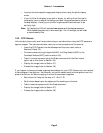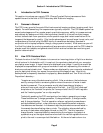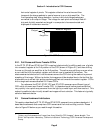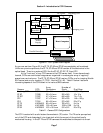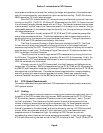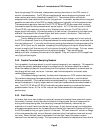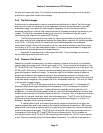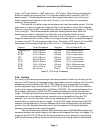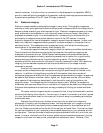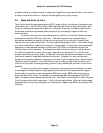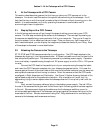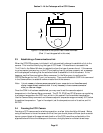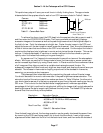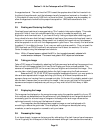
Section 2 - Introduction to CCD Cameras
Page 11
(High = 9µ
2
pixels, Medium = 18µ
2
pixels, Low = 27µ
2
pixels). When binning is selected the
electronic charge from groups of 2 by 2 or 3x3 pixels is electronically summed in the CCD
before readout.. This process adds no noise. Binning should be used if you find that your
stellar images have a halfwidth of more than 3 pixels. If you do not bin, you are wasting
sensitivity without benefit.
The halfwidth of a stellar image can be determined using the crosshairs mode. Find the
peak value of a relatively bright star image and then find the pixels on either side of the peak
where the value drops to 50% of the peak value (taking the background into account, if the star
is not too bright). The difference between these pixel values gives the stellar halfwidth.
Sometimes you need to interpolate if the halfwidth is not a discrete number of pixels.
Another important consideration is the field of view of the camera. For comparison, the
diagonal measurement of a frame of 35mm film is approximately 43mm, whereas the diagonal
dimension of the ST-7E chip is approximately 8 mm. The relative CCD sizes for all of the SBIG
cameras and their corresponding field of view in an 8" f/10 telescope are given below:
Camera Array Dimensions Diagonal Field of View at 8" f/10
Tracking CCD 2.64 x 2.64 mm 3.73 mm 4.5 x 4.5 arcminutes
ST-5C 3.20 x 2.40 mm 4.00 mm 5.6 x 4.2 arcminutes
ST-237 4.74 x 3.55 mm 5.92 mm 8.2 x 6.1 arcminutes
STV 4.74 x 2.96 mm 5.58 mm 8.2 x 5.1 arcminutes
ST-6 8.63 x 6.53 mm 10.8 mm 14.6 x 11 arcminutes
ST-7E 6.89 x 4.59 mm 8.28 mm 11.9 x 7.9 arcminutes
ST-8E 13.8 x 9.18 mm 16.6 mm 23.8 x 15.8 arcminutes
ST-9E 10.2 x 10.2 mm 14.4 mm 17.6 x 17.6 arcminutes
35mm 36 x 24 mm 43 mm 62 x 42 arcminutes
Table 2.2 - CCD Array Dimensions
2.4.6. Guiding
Any time you are taking exposures longer than several seconds, whether you are using a film
camera or a CCD camera, the telescope needs to be guided to prevent streaking. While modern
telescope drives are excellent with PEC or PPEC, they will not produce streak-free images
without adjustment every 30 to 60 seconds. The ST-7E, ST-8E and ST-9E allow simultaneous
guiding and imaging, called self-guiding (US Patent 5,525,793). This is possible because of the
unique design employing 2 CCDs. One CCD guides the telescope while the other takes the
image. This resolves the conflicting requirements of short exposures for guiding accuracy and
long exposures for dim objects to be met, something that is impossible with single CCD
cameras. Up to now the user either had to set up a separate guider or use Track and
Accumulate to co-add several shorter images. The dual CCD design allows the guiding CCD
access to the large aperture of the main telescope without the inconvenience of off-axis radial
guiders. Not only are guide stars easily found, but the problems of differential deflection
between guide scope and main scope eliminated.
Track and Accumulate is another SBIG patented process (US #5,365,269) whereby short
exposures are taken and added together with appropriate image shifts to align the images. It is
supported by the ST-7E, ST-8E and ST-9E camera software, but will generally not produce as
good as results as self guiding, where the corrections are more frequent and the accumulated



